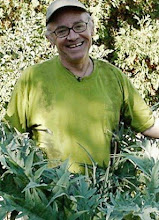 Hydroponic Basil - think how easy pelletized basil seed would be to plant in the cells.
Hydroponic Basil - think how easy pelletized basil seed would be to plant in the cells. Tissue culture begins with meristematic tissue from a mother plant.
Tissue culture begins with meristematic tissue from a mother plant. Once the individual plants grow they need to be separated and planted out.
Once the individual plants grow they need to be separated and planted out. Determinate tomatoes seem good candidates for hoop house production.
Determinate tomatoes seem good candidates for hoop house production. Indeterminate plants need to be de-suckered to successfully grow in a hoop house
Indeterminate plants need to be de-suckered to successfully grow in a hoop house Pollination means shaking the plants when in flower or finding bumble bees to do the job.
Pollination means shaking the plants when in flower or finding bumble bees to do the job. Each basil plant has its roots growing down in a solution that is pumped through the cells.
Each basil plant has its roots growing down in a solution that is pumped through the cells. Personally, the parsley is a true experiment because the basil is more valuable.
Personally, the parsley is a true experiment because the basil is more valuable. Fresh and ready for pesto - very tender flavorful leaves.
Fresh and ready for pesto - very tender flavorful leaves.I had a good visit at Fox Valley Technical College this last week and visited my good friend Jim Beard and the tissue culture lab and the hydroponic greenhouse. Both structures are devoted to not only teaching these skills but experimentation with them too.
The tissue culture lab had a number of specimens growing on culture media under fluorescent lights. Some of them showed signs of needing transplanting as there were multiple plants growing on the mediums. I remember how orchid tissue culture was quickly used to replicate award winning plants. This was especially useful for the first red cattleya and the first yellow phaeleonopsis orchids developed and demand for them made tissue culture plants one sure way to get exact plants of the award winners into more greenhouses.
The Fox Valley hydroponic house had indeterminate and determinate tomatoes growing in buckets and strung up on strings as they grew. Pruning the indeterminate plants was necessary to keep them growing on one main stalk - just like we do here in the summer tomato patch. There were also, as the pictures show, lines of basil and flat leaf parsley destined for the kitchens of the college.
The college has built a much larger hydro house that will be heated with insulated pipes in the floor. A wood burner outside the hoop house will heat the solution that will pass through the pipes and warm a brick floor and the hydroponic hoop house when its finished. I will be back down to Appleton in February and the house should be almost up and running by then.
All of this makes me want to invest in a home system to grow -yup- lettuce. If I had three or four runs with a dozen plants per run, with some good timing, we might be lettuce sufficient here in winter. Using fluorescent lighting and the ambient heat in the basement, the cost might be even with purchasing lettuce from the store. However, I would have to think mine was better. Pelletized seeds are becoming more and more useful all the time - no wonder I liked them from the beginning.
Always something to experiment with and try as each new growing season begins and maybe with hydroponics the growing season here in Wisconsin can be more productive in winter too.
Happy Gardening

































